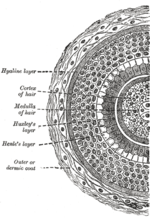Therapsida (redirect from Therapsids)
traits today seen as unique to mammals had their origin within early therapsids, including limbs that were oriented more underneath the body, resulting...
29 KB (2,828 words) - 07:01, 25 July 2024
This list of therapsids is an attempt to create a comprehensive listing of all genera that have ever been included in the Therapsida excluding mammals...
89 KB (2,354 words) - 07:11, 25 October 2023
were described as mammal-like reptiles in classical systematics, and non-therapsid synapsids were also referred to as pelycosaurs, or pelycosaur-grade synapsids...
57 KB (5,746 words) - 14:55, 8 July 2024
Ustia is an extinct genus of biarmosuchian therapsids from the Middle Permian of Russia. It is known from a single species, Ustia atra, which was described...
2 KB (156 words) - 02:48, 5 December 2021
"Hahnia" obliqua (redirect from Hahnia (therapsid))
"Hahnia" obliqua is a poorly known species of meat-eating stem-mammals (cynodonts) that lived during the Upper Triassic in Europe. It is based on tiny...
3 KB (300 words) - 20:04, 29 March 2024
(an arbitrary combination of letters) is an extinct genus of dicynodont therapsids from Russia. Four specimens have been found from the Sokolki Assemblage...
3 KB (247 words) - 11:11, 1 July 2024
more advanced therapsids became dominant during the Middle Permian. Mammals originated from cynodonts, an advanced group of therapsids, during the Late...
224 KB (23,384 words) - 19:16, 1 August 2024
Evolution of mammals (section Therapsids)
(including monotremes), but not present in any of the early Triassic therapsids, is shown in Figure 1 (on the right), namely: mammals use two bones for...
141 KB (15,186 words) - 23:49, 29 June 2024
in flight, the first time among vertebrates, becoming the pterosaurs. Therapsids, the dominant vertebrates of the preceding Permian period, declined throughout...
69 KB (7,517 words) - 21:08, 30 July 2024
sphenacodontians are proto-therapsids (even though there is almost a 30-million-years gap between the separation of the ancestors of therapsids from other sphenacodontians...
7 KB (455 words) - 19:19, 14 April 2024
climate. A possible drop in oxygen levels. Synapsids (pelycosaurs and therapsids) become widespread and dominant, while parareptiles and temnospondyl amphibians...
172 KB (9,499 words) - 03:27, 5 August 2024
Synapsids (mammals as well as all their extinct relatives and pelycosaurid/therapsid ancestors) Extant vertebrates vary in body lengths ranging from the frog...
78 KB (7,108 words) - 04:02, 7 July 2024
Dicynodontia is an extinct clade of anomodonts, an extinct type of non-mammalian therapsid. Dicynodonts were herbivores that typically bore a pair of tusks, hence...
24 KB (2,488 words) - 00:40, 12 July 2024
Dvina, a surface-to-air guided missile from the Soviet Union Dvinia, a therapsid reptile This disambiguation page lists articles associated with the title...
380 bytes (85 words) - 08:03, 23 April 2022
Dinosaurus is an extinct genus of therapsid of controversial affinities. Its type and only species is Dinosaurus murchisonii. It is only known from a...
7 KB (707 words) - 07:34, 20 March 2024
mass extinction (~252 Ma), which wiped out most of the then-dominant therapsid competitors such as the gorgonopsians and anomodonts, and the subsequent...
59 KB (5,566 words) - 04:13, 24 June 2024
mythological beast, and óps 'aspect') is an extinct clade of sabre-toothed therapsids from the Middle to the Upper Permian, possibly even up to the Early Triassic...
76 KB (9,099 words) - 13:26, 2 August 2024
it should be classified as a primitive non-therapsid sphenacodont rather than a genuine basal therapsid. Tetraceratops is known from a single 90-millimetre-long...
6 KB (540 words) - 15:43, 22 July 2024
Eucynodontia ("true dog teeth") is a clade of cynodont therapsids including mammals and most non-mammalian cynodonts. The oldest eucynodonts are known...
6 KB (279 words) - 01:08, 1 March 2024
older term for basal or primitive Late Paleozoic synapsids, excluding the therapsids and their descendants. Previously, the term mammal-like reptile had been...
12 KB (1,185 words) - 15:48, 24 March 2024
synapsids from the Permian. Biarmosuchians are the most basal group of the therapsids. They were moderately-sized, lightly built carnivores, intermediate in...
13 KB (1,226 words) - 16:02, 2 July 2024
descendants of the cynodonts, an advanced group of therapsids, gave rise to the first true mammals. All non-therapsid synapsids, including all basal eupelycosaurs...
10 KB (775 words) - 14:59, 11 May 2024
smoothing, shovel, spade, hoe’) is an extinct genus of herbivorous dicynodont therapsids from the late Permian and Early Triassic epochs (around 250 million years...
27 KB (2,860 words) - 08:29, 24 July 2024
Shaximiao Formation (section Therapsids)
The Shaximiao Formation (simplified Chinese: 沙溪庙组; traditional Chinese: 沙溪廟組 / 沙溪廟層; pinyin: Shāxīmiào zǔ) is a Middle to Late Jurassic aged geological...
25 KB (1,222 words) - 22:53, 8 July 2024
"pelycosaur" synapsids becoming extinct, being replaced by more advanced therapsids. The end of the Capitanian Stage of the Permian was marked by the major...
114 KB (11,778 words) - 04:28, 18 July 2024
Reveals Early Triassic Odd Couple: Injured Amphibian and Aestivating Therapsid Share Burrow". PLOS ONE. 8 (6): e64978. Bibcode:2013PLoSO...864978F. doi:10...
15 KB (1,594 words) - 18:29, 24 May 2024
Dinocephalians (terrible heads) are a clade of large-bodied early therapsids that flourished in the Early and Middle Permian between 279.5 and 260 million...
11 KB (918 words) - 07:36, 29 June 2024
Titanophoneus (category Prehistoric therapsid genera)
("titanic murderer") is an extinct genus of carnivorous dinocephalian therapsid from the Middle Permian. It is classified within the family Anteosauridae...
3 KB (223 words) - 13:36, 16 April 2024
Therocephalia is an extinct clade of eutheriodont therapsids (mammals and their close relatives) from the Permian and Triassic periods. The therocephalians...
31 KB (2,981 words) - 08:20, 11 June 2024
advanced therapsids could have had a combination of naked skin, whiskers, and scutes. A full pelage likely did not evolve until the therapsid-mammal transition...
75 KB (8,498 words) - 18:07, 3 August 2024
























